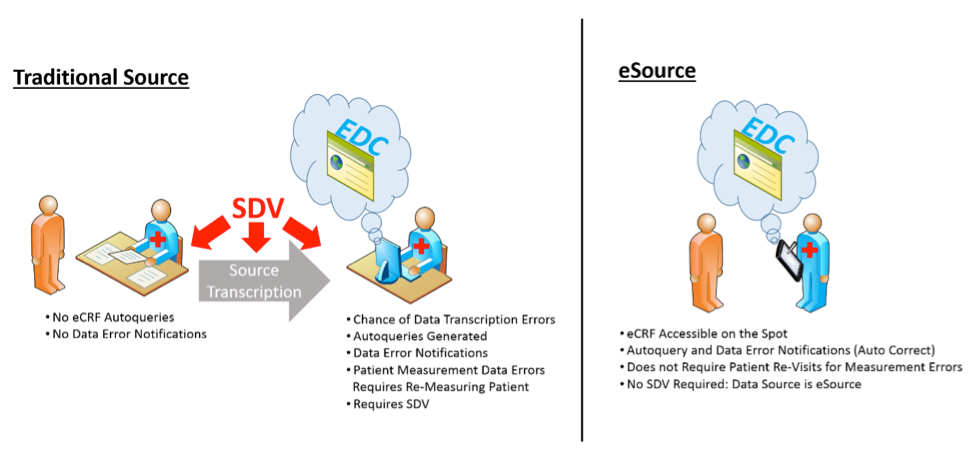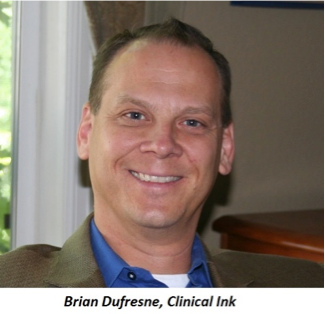How eSource is Transforming RbM
With the clinical trial industry’s focus on improving monitoring efficiency and leveraging a variety of risk-based monitoring (RbM) models, novel eClinical technologies are emerging to facilitate clinical trial monitoring productivity.
With the clinical trial industry’s focus on improving monitoring efficiency and leveraging a variety of risk-based monitoring (RbM) models, novel eClinical technologies are emerging to facilitate clinical trial monitoring productivity. Specifically, eSource is a breakthrough approach that is revolutionizing monitoring by eliminating the need for on-site source document verification (SDV).
While at CBI’s Risk-Based Monitoring for Small to Midsized Organizations Conference in San Francisco, I had the opportunity to interview Doug Pierce (President), and Brian Dufresne (Senior Director) at Clinical Ink, an enterprise offering eSource technology solutions for clinical trials since 2007, and Dr. Leonard Chuck, M.D. (Principal Investigator) of Diablo Clinical Research, a clinical research center in Walnut Creek, CA.
Moe Alsumidaie: How do you feel the biopharmaceutical and CRO industries will react towards the notion of SDV elimination through eSource?

Doug Pierce: CROs are in the middle of changing their business models. One of the primary revenue streams used to be on site monitoring, as 40% to 70% of those monitoring visits were spent on SDV, which is a very expensive resource and poor use of monitor talent. In our experience with Clinical Ink, CROs are becoming increasingly excited about the idea of eliminating SDV and reducing the number of on-site monitoring visits, both of which the FDA has given a green light to. With that said, individual monitors have to be retrained and refocused to break old habits. CROs used to measure monitor performance on the number of queries, how much SDV they did, and metrics that are currently outdated. It’s a sea change for everybody including investigators at sites and monitors at CROs; the change is not necessarily easy, but it’s a welcome change.
MA: From a study site perspective, how has SDV evolved?
Leonard Chuck: In the past, all data capture was on paper, and sponsors used to take the data in-house; not much SDV was done in those days. Now, sponsors are giving us the responsibility of electronic data transcription into EDC, which is prompting so much work and burdens on study sites. Diablo Clinical Research is a large clinical trial center, and 40% to 80% of our work is spent on SDV, which is attributing towards major inefficiencies in clinical research. Monitors are doing clerical work, and that is a waste of talent. eSource can eliminate this clerical work, and produce valuable site operational data, so that the sponsor and CRO can better oversee and understand site operations.
MA: How will eSource eliminate SDV?
Brian Dufresne: In an EDC study, sites capture data on paper, and then transcribe paper bound source into an electronic system. SDV is not verifying that the source data is correct, rather, it is affirming that the transcription of the data is correct. In addition, missing or illegible data may be forever lost or unrecoverable. The reason there is no SDV in an eSource system is because there is only one data set, there is no transcription.

Pierce: In a traditional source model, when patient data goes into an EDC system, edit checks are fired and capture irregularities long after the patient is done with the clinical trial, which makes it particularly challenging during data cleaning efforts. For example, 14 days after a patient is gone, the monitor discovers that a patient’s vitals, such as blood pressure, were noted down incorrectly. With eSource, rather than creating paper source forms, we are working with the sponsor and CRO to create electronic source which runs on tablets. The patient comes in for a visit, the site captures patient data electronically on the source, edit checks are run on the spot, which improves data quality by validating eCRFs in front of the patient and requires sites to enter any missing data.
MA: How can eSource improve data quality and boost productivity at the site?

Chuck: With eSource, we were able to complete data collection in much less time than the traditional approach because so much of the data cleaning efforts and queries are gone. Being able to intervene and repair the data while we still have access to the patient is a great timesaver. Clinical Ink is a smart eSource solution because it offers built-in electronic alerts and customizable conditional logic that help avoid errors in the first place. That’s a huge benefit to sites because physicians tend not to know the details about effective clinical trial design and operations, and they need help building prompts. When prompts are built using an eSource technology, it helps investigators properly do research and improves data quality, resulting in more compliant research.
Pierce: The number one cause of 483’s is improper and insufficient documentation. eSource systems offer guidance and prompts, requiring a mandatory comment on the spot. CROs would benefit as monitors can use their talents to better engage sites, travel less frequently, be more productive during site visits, and can effectively improve remote monitoring due to real time data access. By enabling monitors to look at the documentation and data more holistically, eSource monitors can be more effective in helping to improve the site’s performance.
MA: Is eSource RbM friendly?

Dufresne: Skipping any data review during monitoring puts the principal investigator (PI) at risk, as errors are reflected on the PI’s performance. eSource is RbM friendly because it supports source data review, and realtime data access allows centralized monitors to conduct RbM. With Clinical Ink, there is only one data set: electronic, which is owned by the PI and shared in a portal. This process allows monitors to access the data without going to the site. Subsequently, this means fewer site visits for SDV, and more time for developing relationships with the site and site staff training.
For updates on the evolution of eSource and RbM, don’t miss CBI’s upcoming events: eSource in Clinical Investigations, May 4-5, 2015 and Risk Based Monitoring in Clinical Studies, November 5-6, 2015 in Philadelphia.
CBI is also a UBM Life Sciences company.
Industry Assessment of Risk-Based Quality Management Emphasizes Value of Adoption
April 4th 2024A study conducted by the Tufts CSDD in collaboration with CluePoints and PwC revealed that slightly more than half of sponsors and contract research organizations have adopted risk-based quality management approaches.